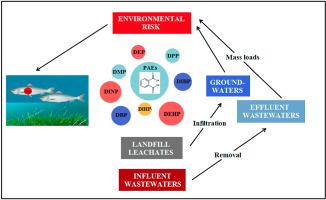Environmental Pollution ( IF 8.9 ) Pub Date : 2020-09-18 , DOI: 10.1016/j.envpol.2020.115643 Urszula Kotowska , Justyna Kapelewska , Róża Sawczuk

|
Phthalates or phthalic acid esters (PAEs) are chemical compounds whose use is exceptionally widespread in everyday materials but, at the same time, have been proven to have harmful effects on living organisms. Effluents from municipal wastewater treatment plants (WWTP) and leachates from municipal solid waste (MSW) landfills are important sources of phthalates with respect to naturally occurring waters. The main aim of this research was determination, mass loads, removal rates and ecological risk assessment of eight phthalates in municipal wastewaters, landfill leachates and groundwater from Polish WWTPs and MSW landfills. Solid-phase microextraction and gas chromatography with mass spectrometry were used for the extraction and determination of analytes. Summed up concentrations of eight phthalates ranged from below LOD to 596 μg/L in influent wastewater with the highest concentration found for bis-2-ethylhexyl phthalate (DEHP) (143 μg/L). The average degree of phthalate removal varies depending on the capacity of a given treatment plant with larger treatment plants coping better than smaller ones. The highest treatment efficiency for all tested treatment plants, over 90%, was reported for dimethyl phthalate (DMP) and diethyl phthalate (DEP). Overall concentrations of phthalates in leachates ranged from below LOD to 303 μg/L while the highest maximum concentration was registered for DEHP (249 μg/L). Overall concentrations of phthalic acid esters in groundwater from upstream monitoring wells ranged from below LOD to 1.8 μg/L and from LOD to 27.9 μg/L in samples from wells downstream of MSW landfills. The obtained data shows that diisobutyl phthalate (DIBP), dibutyl phthalate (DBP), DEHP, and diisononyl phthalate (DINP) pose a high risk for all trophic levels being considered in effluent wastewaters. In the case of groundwater high environmental risk was recorded for DBP and DEHP for all tested trophic levels. Phthalates, in concentrations that pose a high environmental risk, are present in Polish municipal after-treatment wastewater as well as in groundwater under municipal solid waste landfills.
中文翻译:

波兰废水,垃圾填埋场渗滤液和地下水中邻苯二甲酸盐的发生,清除和环境风险
邻苯二甲酸酯或邻苯二甲酸酯(PAE)是化合物,其在日常材料中的使用异常广泛,但同时也已证明对生物体具有有害作用。与天然水相比,市政废水处理厂(WWTP)的废水和市政固体垃圾(MSW)垃圾填埋场的渗滤液是邻苯二甲酸盐的重要来源。这项研究的主要目的是测定波兰污水处理厂和城市生活垃圾填埋场中的市政废水,垃圾填埋场渗滤液和地下水中的八种邻苯二甲酸盐的含量,质量负荷,去除率和生态风险评估。固相微萃取和气相色谱-质谱联用用于分析物的提取和测定。进水废水中八种邻苯二甲酸盐的总浓度范围从LOD到596μg/ L,其中邻苯二甲酸二-2-乙基己基酯(DEHP)的最高浓度为143μg/ L。邻苯二甲酸酯的平均去除程度取决于给定处理厂的能力,较大的处理厂要比较小的处理厂更好。对于邻苯二甲酸二甲酯(DMP)和邻苯二甲酸二乙酯(DEP),报告了所有测试处理厂的最高处理效率,超过90%。渗滤液中邻苯二甲酸盐的总浓度范围从LOD到303μg/ L,而DEHP的最高最大浓度为249μg/ L。上游监测井中地下水中邻苯二甲酸酯的总浓度范围为LOD以下至1.8μg/ L,LOD为27。MSW垃圾填埋场下游井中样品的样品浓度为9μg/ L。获得的数据表明,邻苯二甲酸二异丁酯(DIBP),邻苯二甲酸二丁酯(DBP),DEHP和邻苯二甲酸二异壬酯(DINP)对废水中的所有营养水平都具有很高的风险。对于地下水,在所有测试的营养水平下,DBP和DEHP的环境风险都很高。波兰市政后处理废水以及市政固体废物掩埋场中的地下水中都存在邻苯二甲酸盐,其浓度具有很高的环境风险。对于地下水,在所有测试的营养水平下,DBP和DEHP的环境风险都很高。波兰市政后处理废水以及市政固体废物掩埋场中的地下水中都存在邻苯二甲酸盐,其浓度具有很高的环境风险。对于地下水,在所有测试的营养水平下,DBP和DEHP的环境风险都很高。波兰市政后处理废水以及市政固体废物掩埋场中的地下水中都存在邻苯二甲酸盐,其浓度具有很高的环境风险。



























 京公网安备 11010802027423号
京公网安备 11010802027423号